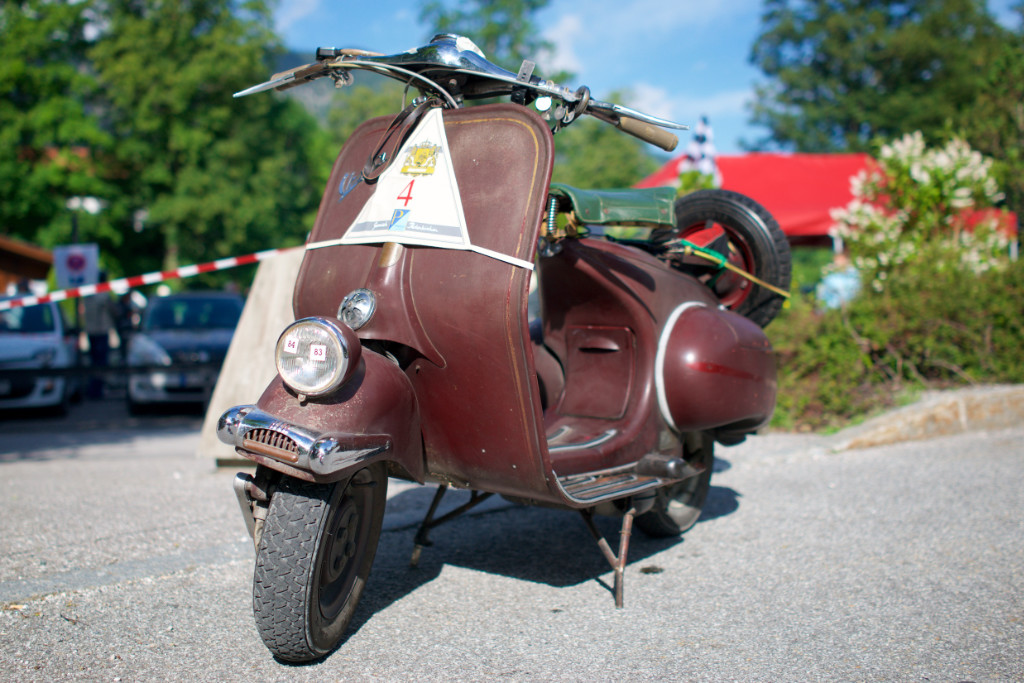When the first Vespa from the Italian manufacturer Piaggio was launched in 1946, no one could have imagined that this moped, born out of necessity, would one day achieve worldwide cult status. Decades have passed since then and the Vespa is still being built, modernised again and again of course, and is still as unmistakable and as popular as ever.
Here, however, the interest will focus exclusively on the first types of the Tuscan Wasp from Pontedera.
What is characteristic of a Vespa Wideframe?
The outstanding feature of this model series is the significantly wider frame compared to later versions, to which the Wideframe naturally owes its name.
The elegant lines and the rounded, curved rear section of the Wideframe are typical. The headlight on the early scooters was still in its original place on the mudguard. Only later in the development of the Vespa did it move to the handlebars. Other unmistakable features are the carburettor flap in the frame and the engine rockers, which are separate from the engine. Finally, the inspection flap below the seat is worth mentioning.
The evolution of the Vespa Wideframe
From 1946 to the beginning of the sixties, about 1.7 million Vespas were sold in Italy alone. An enormous success, which was further increased by countless licensed models produced abroad. But from today’s perspective, not all models were equally important.
Without a doubt, the Vespa 98 is one of the important versions. It was the first Vespa and thus naturally also the first wideframe. With its 98 cubic centimetres of displacement and 3.2 hp, it achieved a top speed of 60 km/h.
The 98 was replaced in 1948 by the Vespa 125, which – the number gives it away – had a new engine with 125 cubic centimetres, which produced 4.5 hp, which was still enough for 70 km/h. The Vespa 125 was the first Vespa to be built. The scooter had a side stand for when it was not in use. From 1951, the V30 series was equipped with a gearstick operated by a cable. This gearstick was more comfortable than the previous system with linkage.

Changes were also made to the front wheel suspension. In the beginning, a front swing arm with a rigid spring was used, but from 1950/51 Vespas with spring and additional damper went into production. Then, from 1955, the suspension strut was fitted, which is still used today.
Another development in the chassis area can be seen in the wheel size. Piaggio had originally used 8-inch tyres, but the 150 GS was fitted with 10-inch tyres. This should lead to an improvement in smoothness on long journeys. An interesting deviation are the Vespas built under licence by the French manufacturer Acma, which used tyres with a diameter of nine inches. Sport Vespas from Piaggio, on the other hand, could use both tyre sizes – the larger ones for long distances, the smaller ones for mountain stages.
Significant were the changes in the engine technology of the Wideframe Vespa, which increased the power quite significantly. Specifically, this involved the changeover from single- to dual-channel engines. From the V33 onwards, the petrol-gas mixture was fed to the cylinder via two channels rather than just one.
The different generations of wide-frame Vespas can also be recognised by the tank volume, which kept increasing.
The changed position of the headlight over time has already been mentioned. While the first models still had the headlight on the mudguard, which is why they are called “Faro Basso” (lamp below), the headlight was moved to the handlebars from the mid-1950s onwards – a position jokingly known as “Struzzo” (ostrich). Even later, the light was integrated into the handlebars. As far as the headlight position is concerned, however, it must be noted that there were always deviations from the standard because the licence builders naturally had to comply with their respective national road traffic laws. Acma-Vespas from France always had the headlight on top of the handlebar. The brightness of the headlight also varied from country to country.

Finally, a purely optical change should be mentioned, which is not insignificant in the course of the wideframe development. This concerns the paintwork. In the course of production, it was changed from the original green to a grey-beige colour.
Interesting in connection with the changes mentioned is that they always affected the original Piaggio Vespas first. Piaggio had obliged the foreign licence builders to continue producing the older versions, while Piaggio itself could already offer new versions. Therefore, Vespas in Italy were mostly more modern than the models abroad.
The special case “Vespa U”
Another Vespa curiosity must be mentioned here, the Vespa U, which came onto the Italian market in 1953. As the pressure of competition on Piaggio increased over time, an “economy version” with scaled-down technology was developed, which could be offered for the equivalent of only 110 dollars. Only 7,000 U models were produced, so that this model is very sought-after by collectors today and correspondingly expensive.
Ever thought about giving your old scooter a small or big upgrade? Here you can find our article on Wideframe tuning with great tips and recommendations.



